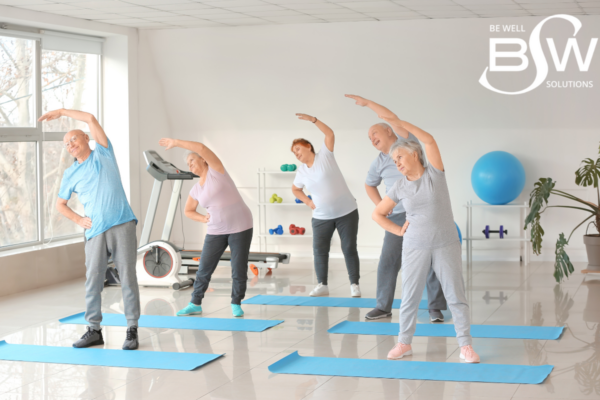Physical activity is a leading component of healthy aging and maintaining mobility. However, exercising consistently and adapting your routine as needed can be challenging to navigate. We can begin by exploring the necessary elements to incorporate into a balanced exercise routine and the benefits of regular activity.
Functional Exercise
According to the American College of Sports Medicine1, “Functional Fitness describes exercises that are designed to help us maintain our physical independence. The goal is to replicate movement patterns we use in everyday life (aka activities of daily living or ADLs) in order to keep us strong and mobile.” Whenever you sit or stand from a chair, you perform the components of a squat. Step-ups imitate the motion of walking up or down stairs. A farmer’s walk with dumbbells or kettlebells simulates walking while carrying items like groceries. Incorporating strength movements that mimic your daily functions helps maintain mobility and independence.
Joint-Friendly Cardio
Aging can come with its fair share of arthritis and sore joints. Keeping your exercise joint-friendly can reduce pain and aggravation. Contrary to what may seem, regular physical activity helps joints maintain their range of motion and improve endurance and overall joint function (Harvard Health2). Choose lower-impact options like walking or elliptical. Or consider non-weight bearing, seated options such as cycling, stationary biking, swimming, or rowing. You should always listen to your body during flare-ups and adjust your exercise routine accordingly.
Build and Maintain Muscle
Muscle mass tends to decline as we age. Research has found that we can lose 3-5% of our muscle mass each decade after 30 years old (Harvard Health Muscle Mass3). Maintaining adequate muscle mass is necessary for supporting our bones and joints and promotes mobility. It keeps your daily tasks more manageable and lowers the risk of injuries. The Department of Health and Human Services4 recommends incorporating strength exercises for all major muscle groups at least two days each week. Be sure to include at least one rest day between exercising the same muscles for adequate recovery and repair.
Balance and Flexibility
Adding balance and flexibility training into your regular exercise schedule can help maintain mobility and lower the risk of injury, especially with age. Stretching will combat stiffness and aid in muscle recovery. Balance training will help promote overall sturdiness and stability. These components allow you to continue accomplishing daily activities more safely.
More Reasons to Stay Active
While we’ve just covered how significant exercise is for good mobility as we age, there are many more ways that regular physical activity can promote healthy aging. It helps keep our immune system working strong to fight against harmful infections and viruses. Exercise helps manage mental health and can improve cognitive function. Studies have shown that those who participate in regular activity see improved memory and focus, and experience less mental decline than those who do not exercise (National Council on Aging5). Exercise is also a primary factor for weight management and lowering the risk of health conditions and disease. It’s never too late to start incorporating consistent activity for healthier results as you age.
Practicing proper form and progression with exercise is essential to reap maximum benefits and avoid the risk of injury. Consider working with a certified exercise professional for a personalized program or approach.
Always consult with your physician before starting a new exercise program.
Continue Reading September 2024 Newsletter: The Science of Stress: Understanding Its Effects on the Mind and Body

